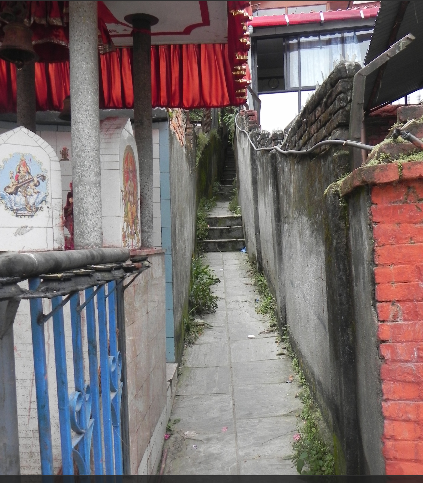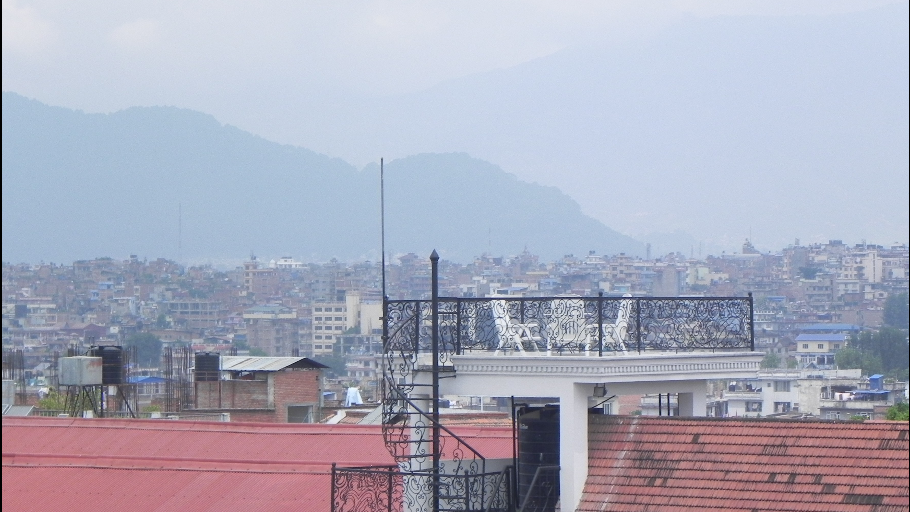Every city has its own wonders and pitfalls. So does Kathmandu, Nepal's capital city. Returning to my hometown after a long stretch in the West was challenging in many ways. But over the past five months, I found ways to reconnect with Kathmandu. Here are ten of them.

1. Amazing Maze of Gallis
Kathmandu is not a city of wide avenues and orderly streets. A large chunk of its public roads are still unpaved, full of potholes and undergoing massive expansions. But every now then, I find myself walking down a galli, which is a shortcut naturally carved out of necessity by foot traffic. They lead from one street to another, some so narrow that even bicycles can't go through. They are so prevalent in the city, yet hidden and tucked away, unknown to people outside the neighborhood. These gallis are unmapped and unnumbered. They are numerous. They form a maze of intersections that evolve over time. They change shape and form. Each one is different and carries with it, its own charm and beauty.
2. The Walks
If only pollution wasn't a problem and there was slightly more thought put into urban planning by previous governments, Kathmandu Valley would be a pedestrian's paradise. One afternoon, I turned around a corner in my neighborhood and instantly paused to appreciate what was in front of me: the road dramatically dipped down and in the distance, the sun was setting behind the hills. Walkways slope up and down in this manner all over the city. For a moment, I was grateful for Kathmandu exactly for what it is and for what it's not: a super-industrialized metropolis of fast cars and giant highways. Walks can lead you through crumbling facades and shrines amidst haphazard private properties, with the hills always in the background. That day, I felt like I was in an otherworldly, ancient place. Many modern cities don't have this characteristic. It is special only to Kathmandu.
3. Easy Access to the Great Outdoors
On a clear May day, I saw a glimpse of Ganesh mountain from a friend's window and since then I have been waiting for the monsoons to pass so that I could get closer to the mountains. Nepal's Himalayas are unmatched in its grandeur and ruggedness and Kathmandu is the starting point for many high-profile expeditions around the country. If not a full-fledged trek, it's easy and cheap to go on a day-hike to one of the many hills that surround Kathmandu Valley. Mountain biking is gradually getting popular as well. And I plan to explore these wonderful opportunities.
4. Balconies, Terraces and Rooftops

You don't even need to leave the city to appreciate Kathmandu's natural beauty. An evening on a Kathmandu rooftop can be a wonderful, luxurious experience. This was one aspect that I missed the most while living in a one-bedroom apartment abroad. I yearned for a balcony or a terrace. Rooftops are such an integral part of Kathmandu's lifestyle that it was a subject of a recent art exhibition. Rooftops have their own culture and history. They can be popular hangout spaces for families or a medium to call out to your neighbor to catch up with her. They are used to dry clothes and spices. More essentially, rooftops allow you to soak up some warm afternoon sun during the winter months. Sadly, due to overcrowding and unregulated construction in the city, many of these rooftops are losing their value but there's Brian's Grill House if all you want is a spectacular 360 degree view of the city.
5. Weather
Kathmandu Valley is located in the Warm Temperate Zone, but due to its elevation (ranging from 1,200 to 2,300 meters), the climate is truly delightful and atypical to the region. Average summer temperatures hover around 30 degrees celsius; the hottest days are often relieved by early evening monsoon rains. I just enjoyed the latest season of monsoon dramatics and the breezy air that is rarely heavy with humidity. Mornings and nights in the winter are going to be difficult (central heating is largely absent) but it rarely gets colder than seven degrees celsius. And I can't wait for the warm afternoons on our rooftop.
6. Pace of Life
Maybe it takes a few years of professional experience in the West to appreciate Kathmandu's pace of life: it's slow, it's more attuned towards individual and social needs and less towards a sense of industry, efficiency and productivity. Religious traditions interrupt work calendars; afternoon tea breaks are often given more importance than office meetings. This can surely be a problem; that's partly why the country is still largely underdeveloped and faces massive economic challenges. As much as I enjoy the freedom of a leisurely Wednesday morning, I do understand the requirements of work and organization. And that's also changing in Kathmandu. The air is now more charged than it used to be. Kathmandu has its share of fast-paced, busy workaholics if you are one of them.
7. Cheap Rent
It's nice to pay ten percent of what I used to. And that number can go down even more if you have modest domestic aspirations. Even though land value has skyrocketed in Kathmandu, the city is still very affordable for renters.
8. Culture (in Transition)
Nepal recently went through a historical political revolution and abolished the monarchy. People's ideologies are changing. Traditional feudal attitudes of past generations are rapidly getting questioned and challenged by a more educated and globally exposed GenNext. Migrants from rural outposts have poured into the city in unprecedented numbers and live side by side amidst the urbanites. More and more people with Western education are returning to Kathmandu and bringing with them cosmopolitan and multicultural values. It's a pivotal time for a city in limbo and a culture in transition.
9. Opportunities
Where there is a great need, there are opportunities. Largely sheltered from the world until the mid-twentieth century, Nepal still lags behind in many areas, primarily education. In the past decade, the country has faced massive brain drain. Nepal desperately needs its citizens to come back. Thankfully, a growing number of its foreign-educated citizens are returning, mainly to Kathmandu, and partnering with their local contemporaries to start ventures in the fields of arts, literature and business. Galli Galli, Photo.Circle, Karkhana, La.lit, Biruwa, Sattya Inc. and our own, Edushala, are such examples of innovative initiatives. We need more of these.
10. Chaos
There may be opportunities, but you can't escape from chaos in Kathmandu: political, bureaucratic, social and emotional. But the daily chaos you face and the physical chaos you notice in its infrastructure somehow maps the internal chaos that is inherent in every human being. Perhaps that's why the western inclinations for absolute order and smooth organization are after all artificial, out of sync with the messiness that is part of all of our lives. The city of Kathmandu somehow reflects our inner human chaos and thus is comforting, in a strange, weird way. It's possible to achieve a different kind of balance in life here. Tourists or temporary visitors may not be able to experience this. One has to live here for a while in order to truly understand why this is so valuable.